Think back to the last time you ran into a conflict with a coworker—how did it go?
Maybe it wasn’t a big deal. Or maybe it led to something like this:
With remote work becoming more popular, you’re probably not spending much time with your coworkers…in person, at least. Working from home can be amazing, but it brings with it a new wave of potential work-related conflicts.
So, how should you deal?
Have you heard of conflict management style quizzes?
You might have no clue what I’m talking about. Or maybe you’re familiar with the concept and ready to learn how to create a conflict management style quiz. Either way, in this guide, I’ll teach you all about the conflict management styles and how to create an online quiz (for free).
Creating a conflict management style quiz will help you:
- Create a lead magnet that works
- Build a deeper connection with your audience
- Spice up your marketing campaign
Sound good? Great! Let’s get started.
Table of contents
- What’s a conflict management style quiz?
- Who should create a conflict management style quiz?
- What’s conflict management?
- What are the 5 conflict management styles?
- How to create a conflict management style quiz with Interact
- How to promote your conflict management style quiz
- 3 ways to optimize your conflict management style quiz
What’s a conflict management style quiz?
Before I explain what a conflict management style quiz is, I’ll go over what conflict management styles are.
How do you deal with conflict? Are you the type to walk away, or do you fight to win? Do you avoid arguments, or welcome them?
Your conflict management style tells you how you manage conflicts and why. As you learn about your style, you’ll begin observing your behavior in arguments . . . for better or worse.
On that note, a conflict management style quiz tells you what style you are after answering a series of questions.
So who creates conflict management style quizzes? And why?
Who should create a conflict management style quiz?
This type of quiz is popular for the professional-development, psychology, and personal- development industry.
People who create conflict style quizzes usually want to help their users improve communication skills. Arguments will happen whether you like it or not—you might as well learn how to solve them effectively.
Learning this skill will help people improve professionally as well as personally:
Personal life — Let’s face it: our loved ones can drive us crazy from time to time.
A conflict management style quiz will help your audience notice recurring patterns with their partner, children, and friends. Offering this quiz will encourage them to take the first step to improve their personal relationships.
If you want to dive even deeper into personal development, check out our attachment style quiz tutorial.
Professional life — A big part of a person’s career is interacting with people outside of their social circle.
There will always be moments of irritation and conflict with coworkers. In fact, companies often lose billions of dollars due to arguments and low work performance!
Understanding your conflict management style will help you find solutions quickly and therefore work smarter. And if you’re a professional career coach or psychologist, you can help your clients become better workers with this quiz.
While this guide is focused on professional relationships, you can apply it to other parts of your life as well.
Now that you know what a conflict management style quiz is, let’s talk more about conflict management and each style.
What’s conflict management?
Back in the 1970s, psychologists Thomas and Kilman brought forward the idea of conflict management.
While most of us have a negative view of the word “conflict,” they felt the opposite.
Thomas and Kilman understood the benefits of arguing. And no, I’m not talking about yelling, insulting, and blaming.
I’m talking about debating, challenging, and questioning. Healthy conflicts can often bring new perspectives, questions, and insights into our lives.
Have you ever left an argument thinking: Wow, I never thought about it that way until now. Maybe I should reevaluate. If so, you probably just had a healthy argument.
What are the 5 conflict management styles?
Before you create a conflict management style quiz, you should learn what each style looks like in real life. If you already know about the different conflict management styles, you can jump to our online quiz tutorial.
Thomas and Kilman came up with five conflict management styles:
- Compromising conflict style
- Avoiding conflict style
- Accommodating conflict style
- Competing conflict style
- Collaboration conflict style
They placed each conflict management style on a spectrum of cooperation and assertiveness.
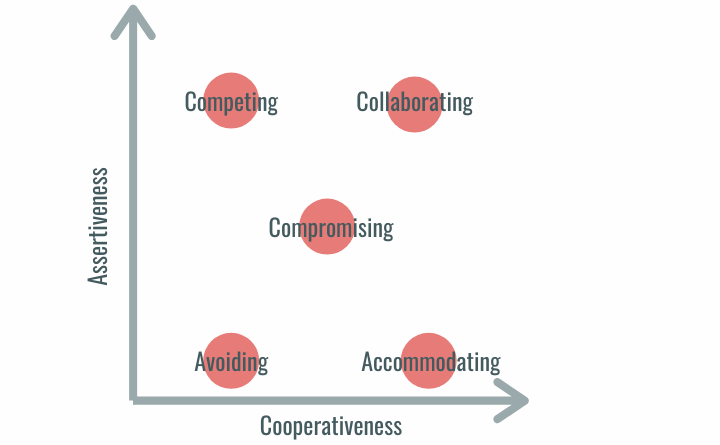
For example, someone with an accommodating conflict style is high on cooperativeness but low on assertiveness. Alternatively, a competing type is high on assertiveness but low on cooperativeness.
As you read more about each style, you’ll learn the pros and cons of each type—and the better your conflict management style quiz will be.
1. Compromising conflict style
You can probably guess the main behavior of someone with a compromising conflict style.
You got it! They compromise. People who relate to this conflict style like to find the middle ground between both parties, so everyone benefits to some extent.
Compromising conflict types land smack dab in the middle of assertiveness and cooperativeness. This makes sense, as a compromise isn’t right or wrong, but somewhere in between.
So how does a compromising style interact in an argument?
Jane, Mike, and Paula work at a pizza shop. Both Jane and Mike are asked to create their very own pizza—the best pizza recipe will become a signature pizza. Paula, the manager, will choose the winner.
Jane creates a pepperoni pizza with jalapeno peppers. She claims her pizza is the best because it’s a classic pizza with a “twist.” Mike creates a supreme pizza with ten different toppings. He thinks his pizza is the best because it’s original.
Jane thinks Mike’s pizza is crazy. She says, “Nobody will want to try a pizza like that!”
Mike thinks Jane’s pizza is boring. He says, “There’s nothing special about a pepperoni pizza with jalapenos.”
To solve this problem, Paula offers a solution. “Why don’t we put both of your recipes together? Let’s create a pepperoni pizza with jalapenos and three of Mike’s toppings. We can call it the ‘Supreme Pizza.’ That way, both of you win.”
In this scenario, Paula uses a compromising conflict style to solve Mike and Jane’s argument. As you can see, neither Jane nor Mike won the best pizza. Instead, they both contributed to the newest pizza.
The pros of a compromising conflict style — This style is all about the solution to the argument. Instead of trying to win, they’d rather find a solution in the middle. When you compromise, you save time and go straight to the solution.
The cons of a compromising conflict style — While this style avoids a huge fight, it also takes away winning and losing. Nobody will leave the room completely satisfied. Sure, compromising is fair—but sometimes fair isn’t the best answer.
Someone with a compromising conflict style may show these traits:
- Practical
- Strives toward fairness and equality
- Wants to find a fast solution
- Doesn’t care about winning or losing
2. Avoiding conflict style
An avoidant conflict type disengages from arguments. This type avoids conflict because they’re intimidated or they don’t think the problem is worth resolving.
A person acting in an avoiding conflict style might behave like Nathan in the scenario below.
Nathan and Harry work at the marketing agency, Digital Creative. Digital Creative is holding its annual conference in one month. All the marketing agencies in the state are invited—it’s a big deal.
Nathan and Harry are in charge of creating the “Welcome presentation” for the conference. Three days before the conference, Nathan tells Harry, “Hey, Harry. I noticed you haven’t done your part in the welcome PowerPoint. The conference is in three days, and we have to turn it in tomorrow.”
Harry shrugs. “I have a big project due with a client tomorrow. I’ll get my part done after that.” Harry ended the conversation and went back to work.
If Nathan and Harry don’t turn in a complete presentation by tomorrow, they’ll get in trouble. Harry’s feedback was indecisive and unhelpful. Nathan will probably have to finish Harry’s part himself. The conflict wasn’t solved; it only got worse.
The pros of an avoiding conflict style — This conflict management style is beneficial if there are bigger problems to handle first.
For example, it’s better to finish a big work project due tomorrow than another project that is due in two weeks. Avoiding conflict can be good, as long as you plan to solve it at some point.
The cons of an avoiding conflict style — This conflict style doesn’t work well if something needs to be solved ASAP. Harry’s lack of response only made the problem worse. If he had been more engaged in the conversation, the problem could’ve been solved then and there.
Someone with an avoiding conflict style may show these traits:
- Indecisive
- Anxious
- Focused on one task, and one task only
- Unaware of others’ needs
3. Accommodating conflict style
This conflict style is known as the “people pleaser.” People who relate to this conflict style want to please their colleagues so badly that they’d rather keep their opinions to themselves than cause a disagreement. Because this style always agrees with the other person, arguments rarely start in the first place.
Consider the below scenario, for example:
Elena and Sarah landed tutoring gigs at a non-profit organization. Eric, the manager, asks Elena and Sarah to create a tutoring schedule for the K–3rd graders.
Elena tells Sarah she’s free to work on the schedule this Thursday. Sarah has a shift at her other job on Thursday. But instead of asking Elena to reschedule, she switches her shift to accommodate Elena’s needs.
Elena never knew Sarah had another shift and is happy with the agreement. Sarah, though, is secretly upset that she switched her shift, but still she’s happy to have pleased Elena’s request.
In this scenario, there was no conflict because Sarah didn’t open up about her previous commitment. If Sarah had told Elena about her other shift, they could’ve chosen another day that fit both of their schedules.
The pros of an accommodating conflict style — This approach can be helpful if the situation truly does not matter to you. For example, switching shifts with a coworker can be a healthy accommodation. Your coworker is asking for help, and you’re able to switch without causing conflict with your schedule.
The cons of an accommodating conflict style — This style can often turn into people-pleasing. When you people please, you only hurt yourself in the end. Neglecting your own needs usually ends with resentment.
Someone with an accommodating conflict style may show these traits:
- Passive
- Forgets their own needs
- Afraid of arguments
- Considerate
4. Competing conflict style
A person with this conflict management style thinks there is a loser and winner in every fight—and they always win. Someone who uses this style can get caught up in power and control. Their goal isn’t to solve the problem at hand, but to get their way.
How does someone with a competing conflict style act?
Riley runs a restaurant downtown. Every week, he meets with his employees to give them their assigned tasks for the week. Riley enjoys these meetings because he can assure himself that things are going his way.
His employees, however, hate the weekly meetings.
“I’m so fed up with Riley. My work schedule doesn’t work with my class schedule,” Monica complains to Denzel.
“Why don’t you just talk to Riley?” Denzel asks.
“I do! And every time, Riley shuts me down. As soon as I find a new job, I’m quitting.”
Riley runs a “my way or no way” policy at his restaurant. While this keeps most tasks in-line, it also causes conflicts with his employees.
The pros of a competing conflict style — We all come across non-negotiable situations at work, which are usually emergencies or financial in nature. These types of conflicts usually need to be decided quickly and authoritatively.
The cons of a competing conflict style — Using this style too much will steer you away from the solution. Solving the problem should be the primary focus, not power and control.
Someone with a competing conflict style may show these traits:
- Stubborn
- Confident
- Focused on being right
- Would rather disagree than agree with someone
5. Collaboration conflict style
This conflict style is known as the “win-win” solution. A collaboration conflict type wants everyone to state how they feel about the issue at hand. A person with this conflict management style puts in the time and effort to think of the best solution.
Lianne runs a small tech company with 15 employees. The first three years of her business felt like a failure—meetings were a pain to coordinate, her employees worked according to their own schedules, and goals weren’t met.
After some speculation, Lianne scheduled mandatory weekly company meetings. She encouraged open-communication for each meeting—every employee was asked to express their wins, losses, and concerns for the week. Lianne also restated the company’s short-term and long-term goals.
Three years later, Lianne’s company is fully funded.
Lianne realized that her company would fail without the collaboration of everyone on the team. She made sure all of her employees aimed for the same goals.
The pros of a collaboration conflict style — This style confronts the good and bad elements of a situation. It also gives each person a say in the argument, which makes it easier to find a solution for everyone.
The cons of a collaboration conflict style — This conflict management style doesn’t solve things quickly. It takes a lot of time and effort from every worker to achieve a win-win solution. This doesn’t mean it’s impossible to use this style, but everyone has to be on board.
Someone with a collaborative conflict style may show these traits:
- Welcomes criticism
- Wants the best solution for everyone
- Isn’t afraid of conflict
- Communicative
Which conflict management style is the best?
Short answer: There’s no best conflict management style.
Each conflict style comes with pros and cons. Some situations call for an accommodating style while others need a competing style. What it comes down to is your ability to be open-minded about each conflict style.
Use your judgment to decide which conflict management style is best for the situation. I also recommend learning to communicate with all types. The more people you learn to work with, the better off you’ll be in your career.
Keep this in mind as you create your quiz: Don’t make users feel bad about their style. Instead, let them know the pros and cons of their style and how to become better workers and communicators.

How to create a conflict management style quiz with Interact
Create a conflict management style quiz with these six easy steps.
1. Choose a template
2. Choose your style
3. Design the cover page
4. Design the questions page
5. Create your results
6. Correlate your results
1. Choose a template
On the home page, click “Create new quiz.”

Our software offers several templates you can use. Or you can start from scratch, which we’ll do in this tutorial.
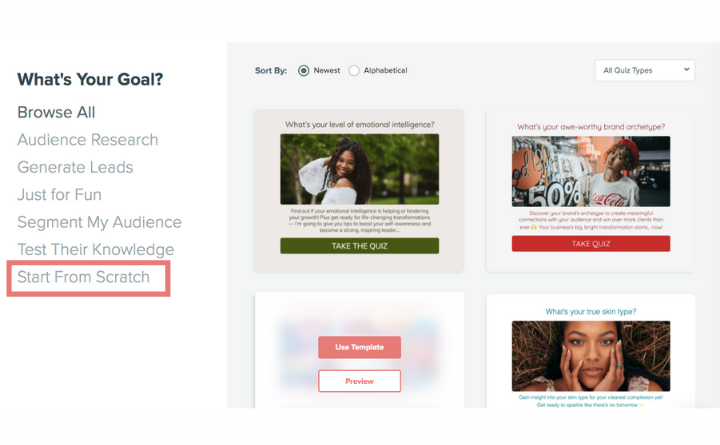
From here, choose what type of quiz you’d like to create. For conflict management styles, we’ll choose “Personality.”
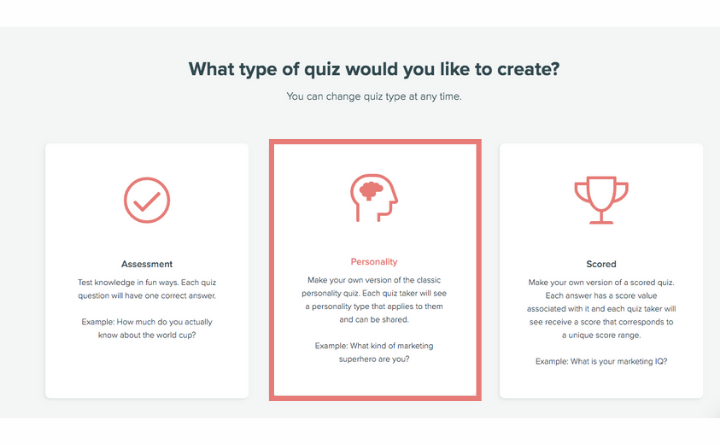
Your dashboard should now look like the image below. Let’s get to designing!
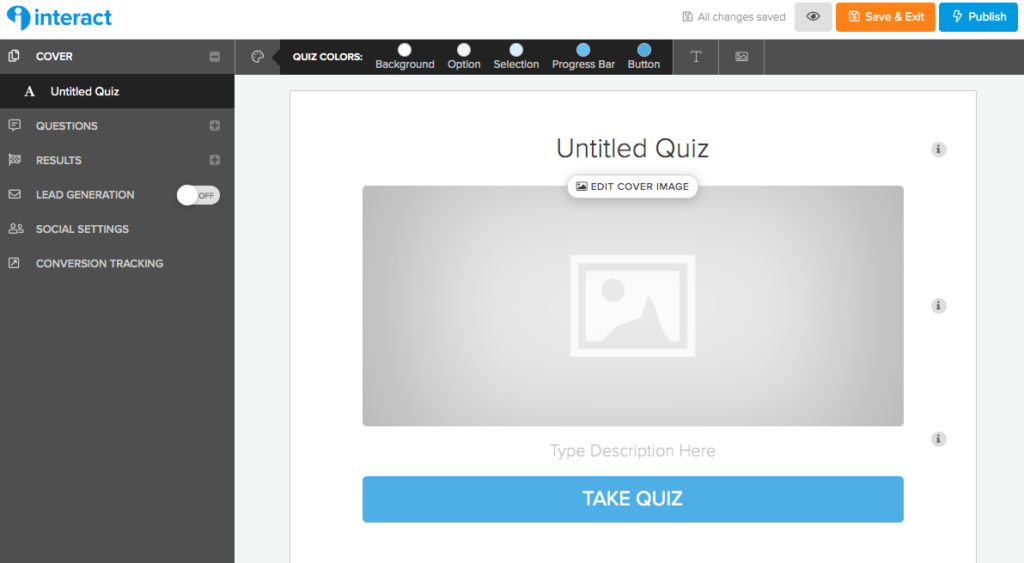
2. Choose your style
These next few steps are all about design. Feel free to check out how to make a personality quiz for more ideas.
First, we’re going to change the quiz colors, font, and logo. You can access all of these options at the top toolbar.

Let’s start with “Quiz colors.” Think about your brand. What colors do you use for your business?
If you don’t have a color scheme for your brand, you can always refer to the color theory for quiz design.
After you choose quiz colors, click “T” in the toolbar.

Google Fonts offers hundreds of styles to choose from. We suggest a readable font or your brand font.
Last, click on the photo icon next to the font.

Your logo will show up in the right bottom corner of your page. Your logo helps online users remember your business when they take your quiz.
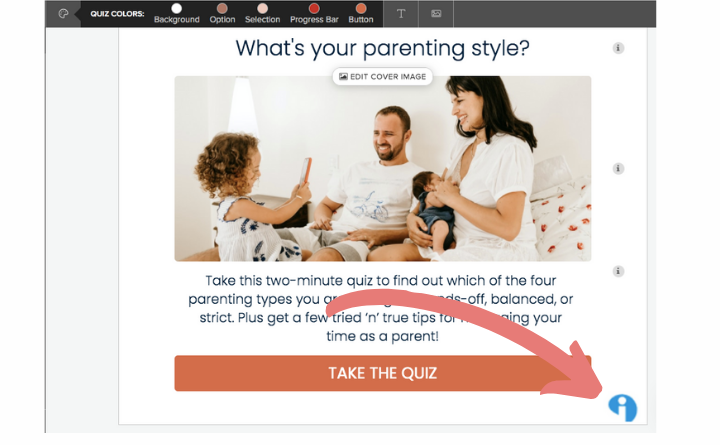
Your quiz-style is ready to go. Let’s get to the content.
3. Design the cover page
Your quiz cover page is the first thing online users will see. Make it short, sweet, and exciting. It shouldn’t give too much information.
We’ll start with the quiz title. Choose a simple title that gets to the point, like “What conflict management style are you?
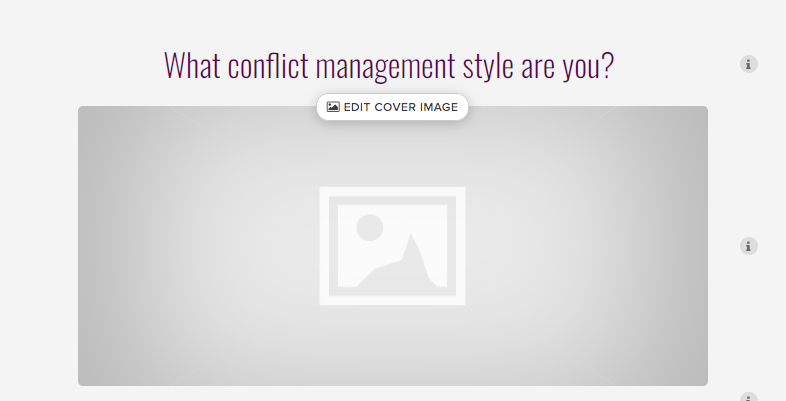
Next is the image. Click “Edit cover image” to search for a relevant image. Because conflict management styles relate to careers, we searched for “workplace” and decided on this:
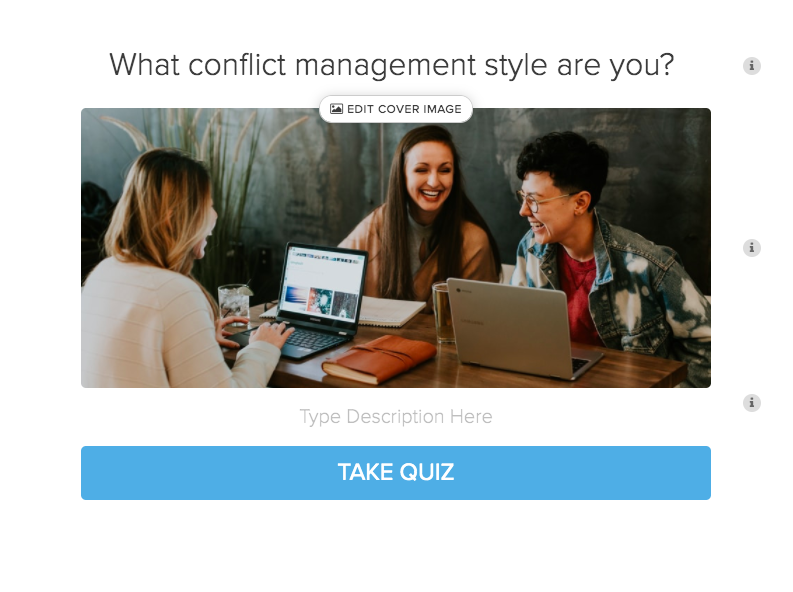
Like your quiz title, the description should be short and sweet.
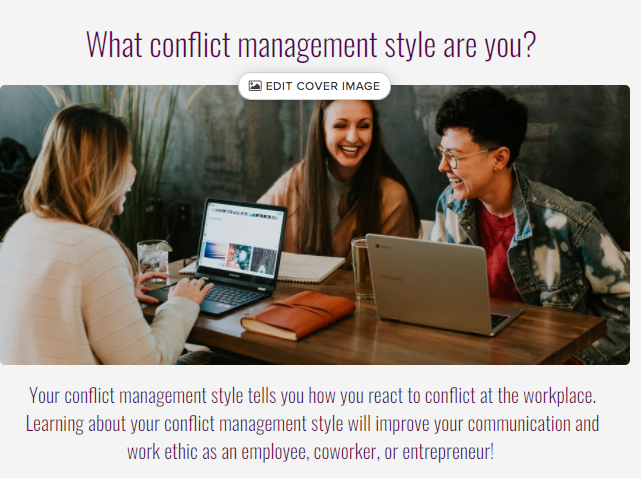
Notice how this description tells users what conflict management styles are and how learning about them can benefit their proessional relationships.
Last is the call to action. You can keep it simple, like “Take Quiz,” or you can keep it in tone with your quiz.
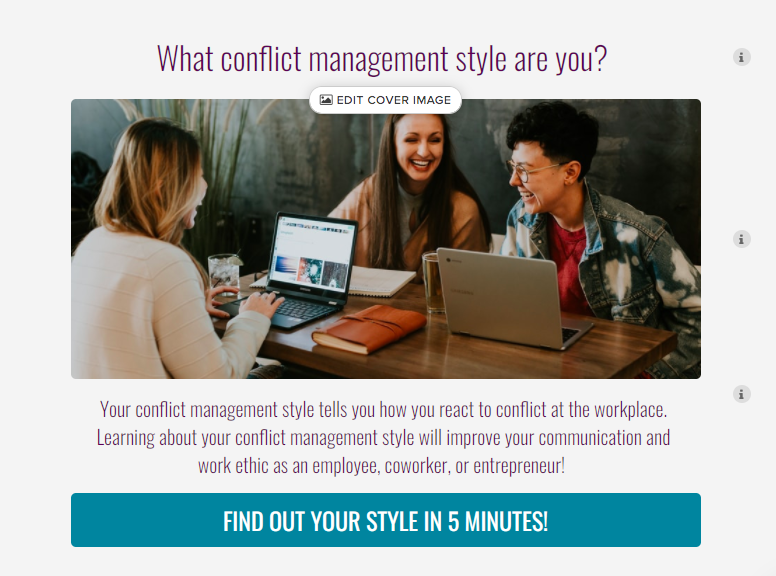
Quick tip: Highlight the length of your quiz if it’s short. Most users don’t want to spend too much time taking a quiz.
A CTA like “Find out your style in 5 minutes!” tells readers they’ll get results fast.
4. Design the questions page
In this step, we’ll focus on the question settings. If you need question ideas for your conflict management quiz, head to this section.
In the beginning, your questions page might look like this:
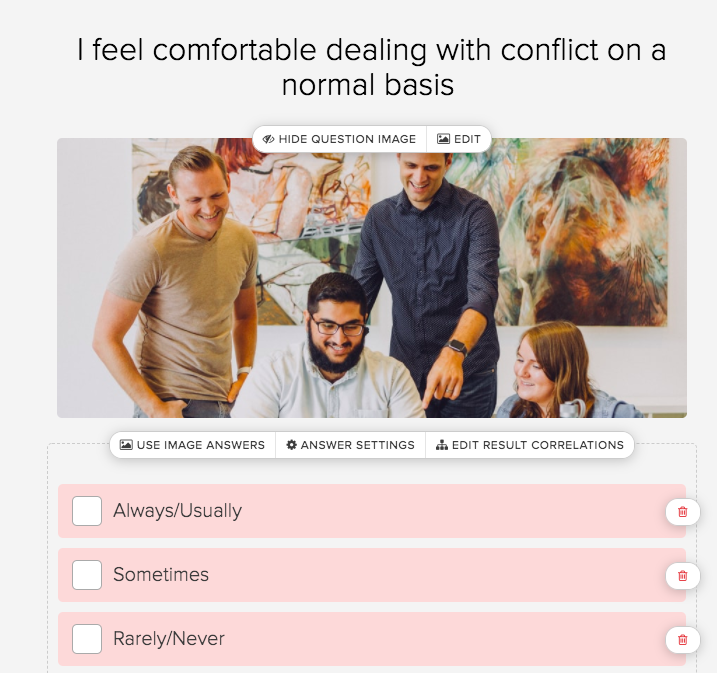
This looks pretty good, but something’s missing.
Click “Use image answers” to add images to enhance your quiz design. Images also help visual learners better understand the answer choices.
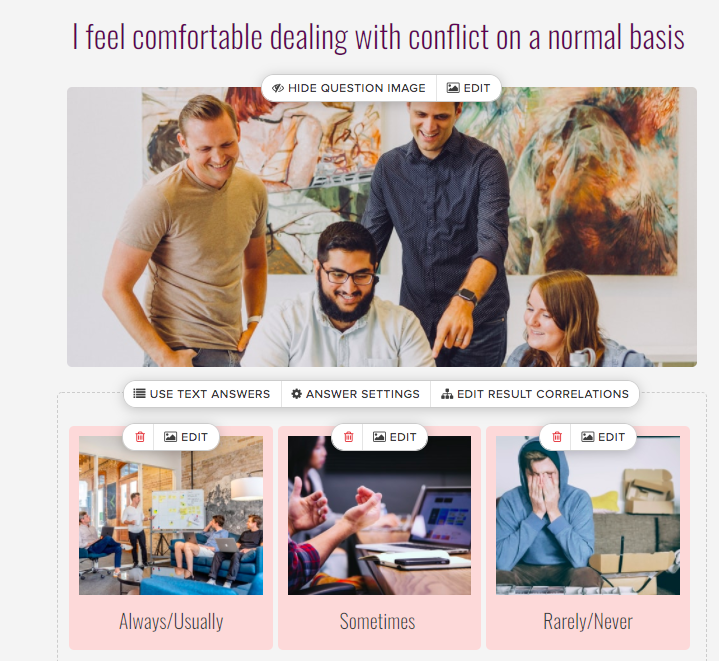
Speaking of answers, you can allow users to select multiple answers. Just click “Answer settings.”
Last is “Edit result correlations.” This setting correlates your results to each answer. We’ll head back to this setting after you create your results.
5. Create your results
This is the most important part of your conflict management style quiz. The results page is a lead generation machine.
After a user gets their results, direct them to your services, online courses, or products. In this step, we’ll help you design a result landing page that converts.
First things first: head over to the “Results” section on the left-side toolbar. We’ll start with the “Title.”
The results title reveals the user’s results.

Pretty straightforward, right? Next, click “Show result image” and choose a photo.

Now let’s talk about the description. In this first section, describe the behaviors of the conflict management styles. This can be brief.
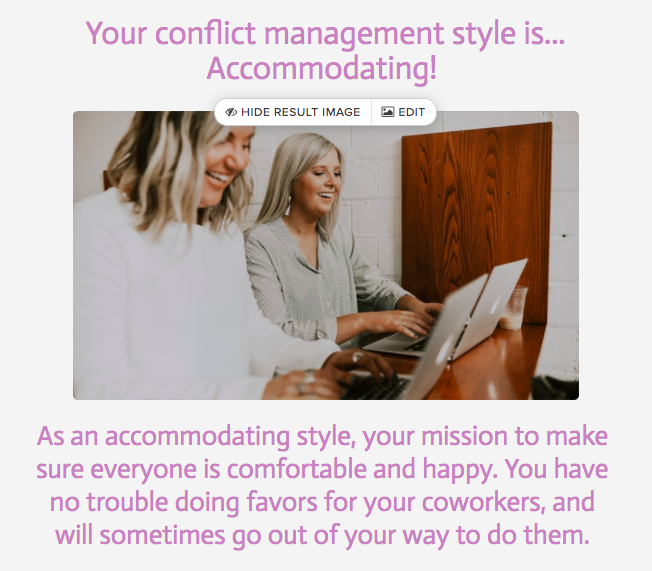
To keep your audience interested, add images or GIFs. To add an image or GIF, click on the image icon at the top right.

We recommend adding more info about their conflict management style throughout the results page. Focus on the user and offer advice to improve their conflict style.
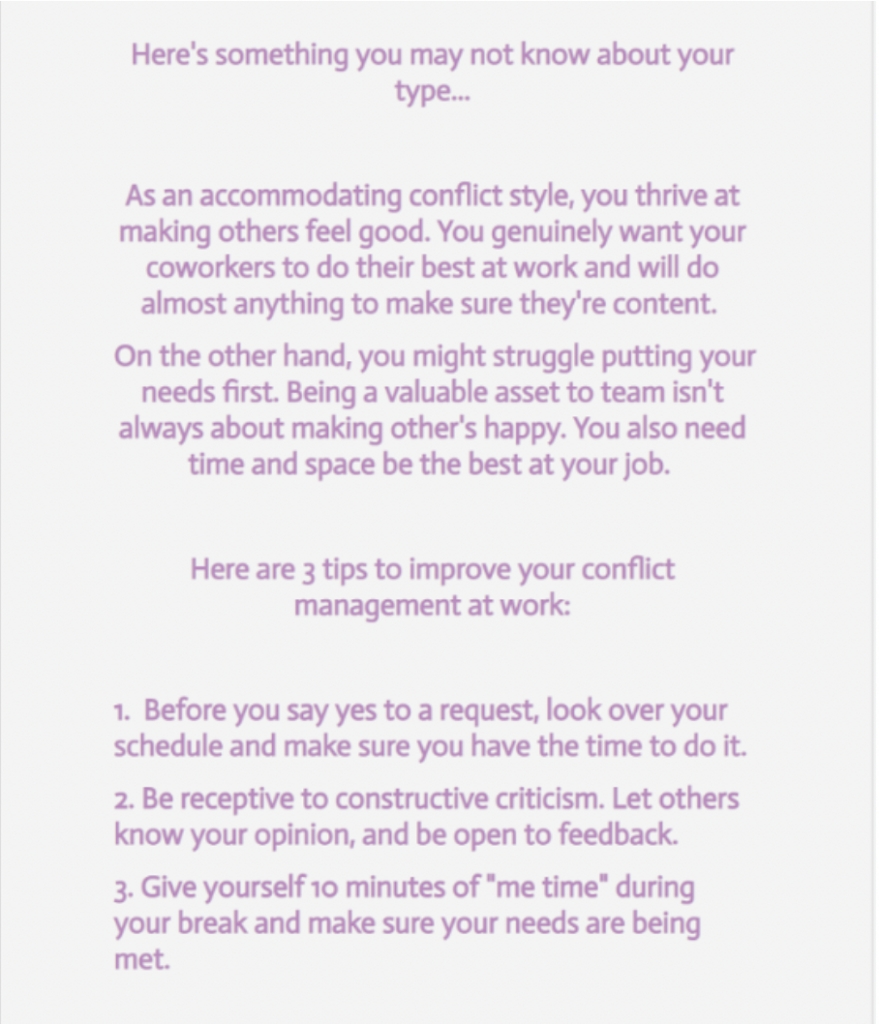
Did you create content around your conflict management style quiz? Add it to your results page.
Click on the link icon in the top menu to link each resource.

And now we’ve come to the finale—the call to action.
This is where users get excited about your services. High converting CTAs can lead to big results. Ashley Beaudin, for example, received over 3,000 leads—in ONE week.
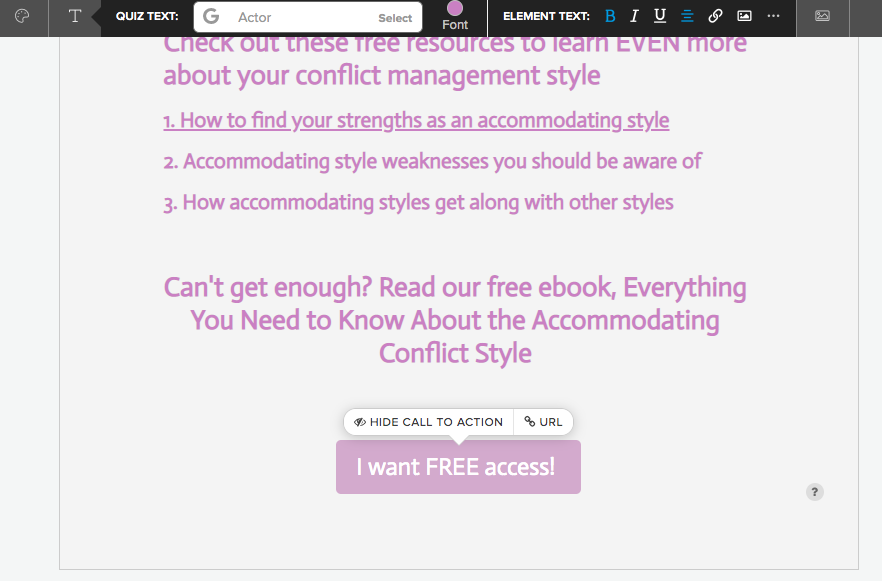
All done! You can learn more tips and tricks about result landing pages, or head to the next step.
6. Correlate your results
Before you publish your interactive quiz, make sure your questions are correlated to your results.
Head back to questions and click “Edit result correlations.”

From here, correlate your questions to each results page. This is how a typical quiz correlation looks.

If you have multiple answers, correlate an answer to more than one result. When you’re done, click “Preview” and make sure your quiz is ready to go.

Your conflict management style quiz is officially ready!
How to promote your conflict management style quiz
To get as much lead generation as possible, promote your quiz on your website and social media.
1. Create a landing page
A quiz landing page is a great way to advertise your quiz launch. When you build a quiz landing page, it tells your audience:
- What conflict management styles are
- Why they should take a conflict management style quiz
- What they’ll get in return
Kay Putnam, for example, generated 100k from her brand personality quiz. Let’s take a look at her winning landing page.
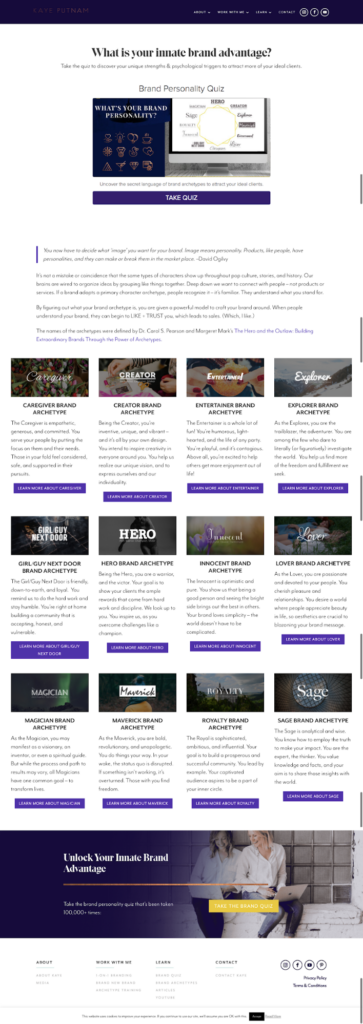
At first glance, Kay’s quiz landing page is visually stunning. She uses consistent brand colors and images to draw attention to her quiz.
Call to action: Notice how she adds a CTA at the beginning and end of her landing page? Eager users can take the quiz right away. Or, they can learn more about the brand archetypes before taking the quiz.
Brand style description: This section is different from other quiz landing pages. Kay offers free information about each archetype.
When quizzes sit at the top of the quiz funnel, most users don’t learn anything about your business. When you offer free content, they can explore and get excited about your quiz.
Web copy: Kay’s landing page copy is consistent. She identifies her audience’s needs (creating a trusting brand) and shows them how to meet those needs (learn your brand archetype).
Your quiz landing page should connect with your audience. Don’t just tell users to take a conflict management style quiz—tell them why and how with free content and resources.
Not sure where to start? We recommend creating a quiz landing page with Unbounce.
2. Run Facebook ads for your conflict management style quiz
Do you use social media ads? Well, here’s an idea: Use them to promote your conflict management style quiz!
There are a few reasons Facebook ads can boo st leads:
You can customize your audience: You can use demographics, behaviors, and interests (among other things) to target the right users on Facebook. Best of all, you can retarget users who interact with your Facebook ads.
They retarget visitors: That’s right, you can advertise your quiz to users who:
- Visited your website
- Started your quiz but left in the middle of it
- Finished your quiz and didn’t click on your CTA
They’re Interact friendly: Embed your conflict management style quiz to Facebook Ads in just a few steps.
Note: You have to create your Facebook Ads first. Our guide on retargeting users with Facebook Ads can help you.
In your account, click “Share & Embed.”

Next, click “Set up Facebook Ad for your Quiz.”
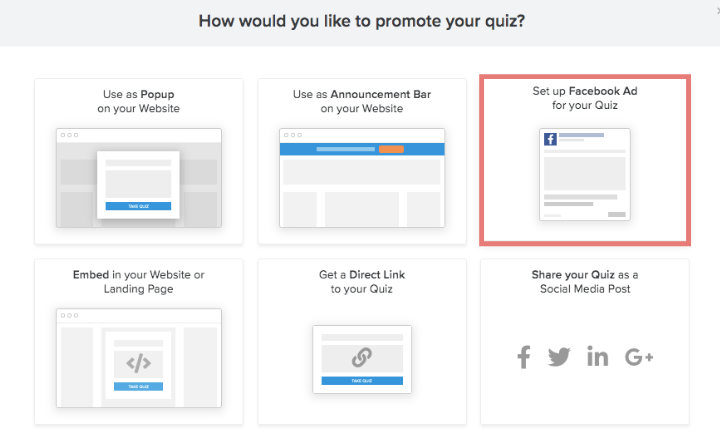
You’ll notice a quiz URL. Click “Copy Quiz URL to Clipboard” and add it to your Facebook Ad campaign.

On the right, Interact will recommend a Facebook Ad design for your quiz. You don’t have to follow this template, but it’s a good place to start.
If you want to retarget users who visited your quiz through your site, add conversion tracking. You can find “conversion tracking” on your quiz editing page.
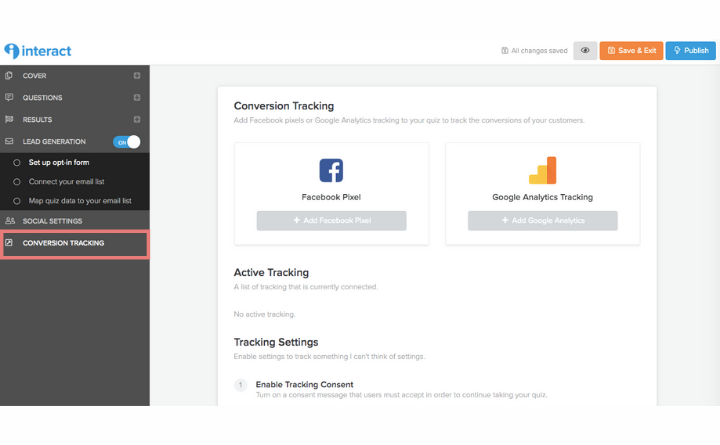
Under Facebook Pixel, choose “Add Facebook Pixel” to enter your ID. Your Facebook Pixel ID is in your Ads Manager account.
For more information, read our tips for getting more clicks on your Facebook ads and our Facebook Ad case study.
3. Encourage social sharing
When someone finds something interesting online, what do they do?
They share it with their friends, family, and followers. With this much access to online information, we’re always sharing content.
With Interact, you can create social sharing templates on Facebook, Twitter, LinkedIn, and Google.
In this tutorial, we’ll focus on Facebook. But before you create a template, let’s check out what your quiz looks like on Facebook.
Click “Share & Embed” as you did in step 2 of this section. Next, choose “Share Your Quiz as a Social Media post.”

Again, this guide will use Facebook as an example.
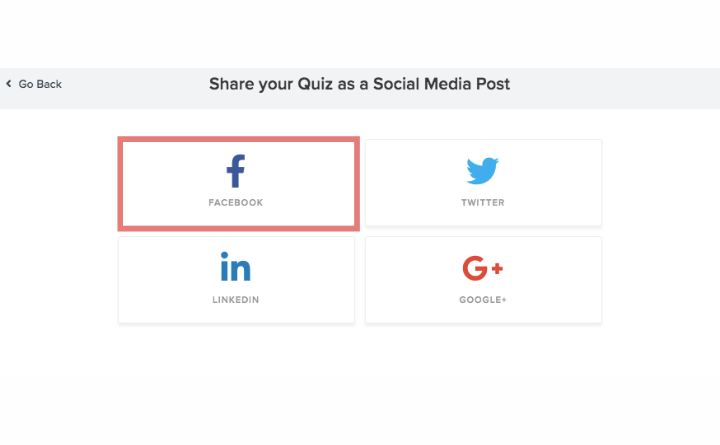
From here, you can see what your quiz would like if someone were to share it.
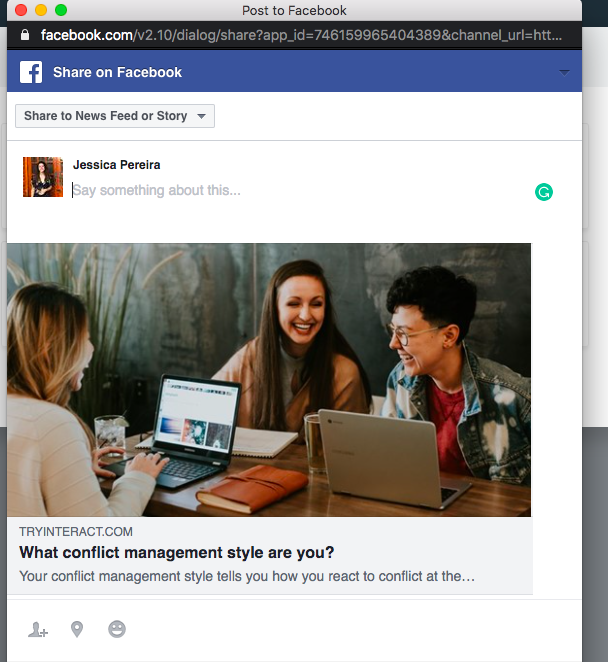
Everything looks good, but we’re going to change the featured image. To do this, head back to your quiz editing page and go to “Social settings.”
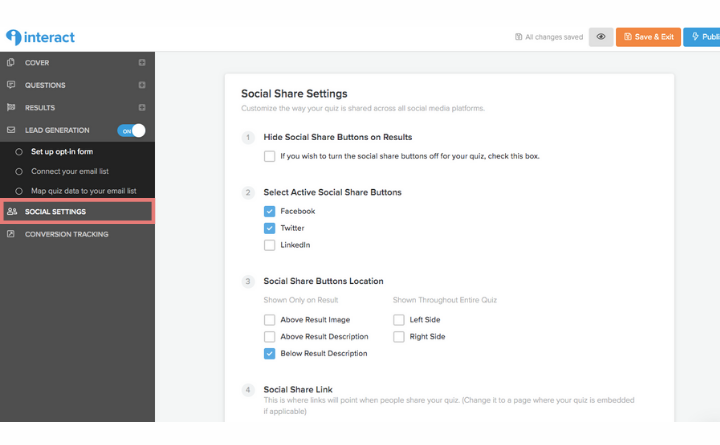
Step 1: Keep this box unchecked to allow social sharing for online users.
Step 2: Choose which social sharing buttons to add to your quiz.
Step 3: Decide where you want your social share buttons placed.
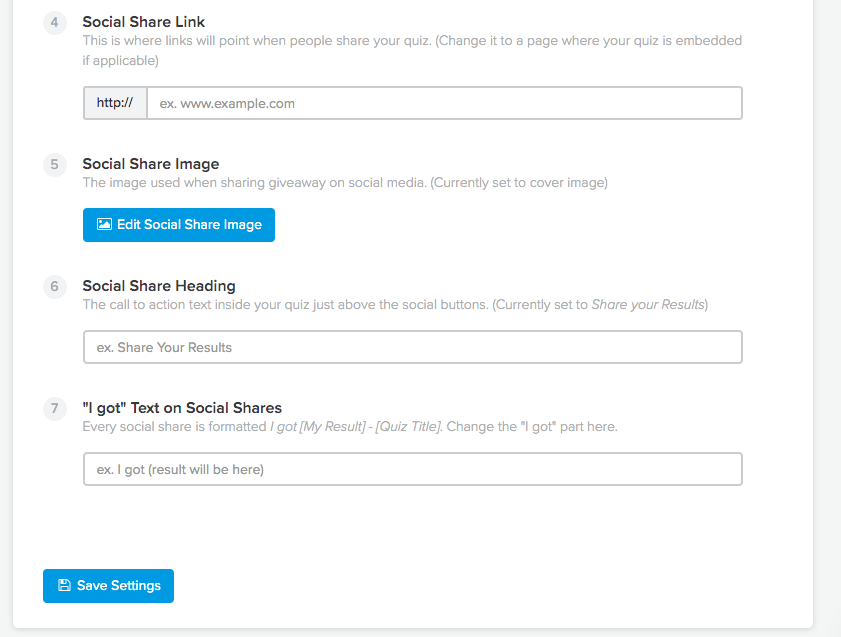
Step 4: Link your conflict management style quiz.
Step 5: Replace the featured image.

Step 6: If you don’t want “Share Your Results” as the heading, change it to something else, like the title of your quiz.
Step 7: When a user shares your conflict management style quiz, it’ll say, “I got (result here)!” Feel free to keep or edit this copy in this step.
Now that we’ve updated the social sharing settings, let’s see what it looks like now.
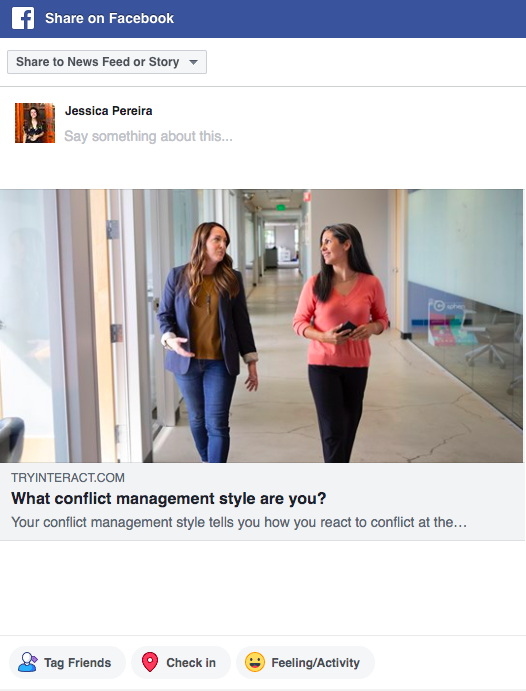
Success! The featured image changed. You can always head back to your social sharing settings to change features as needed.
You can learn more about promoting your quiz on social media with these guides:
- How to work quizzes into a social media strategy to drive engagement
- 10 online quiz examples that won the social sharing game
3 ways to optimize your conflict management style quiz
With every online marketing tool comes optimization. To get the best results out of your conflict style quiz, consider these three optimization tips.
1. Ask interesting questions
Take a look at your conflict management style questions. Are they relevant? Do they make sense?
And most importantly, are they interesting?
Insightful quiz questions keep your audience engaged. They’ll think, I can’t wait to see what my conflict management style is!
We brainstormed ten questions that you can use for your conflict management style quiz.
The first five questions are situational. Situational questions are always easy to answer—they get readers thinking about their behaviors and reactions.
Situational conflict management style questions:

- How do you react to drama in the workplace?
- Your boss asks you to finish a project you REALLY don’t want to do. How do you approach her about it?
- A coworker confronts you about your workflow. He doesn’t think you’re as committed to the company as the rest of the team. How do you react?
- You’re the founder of a company. How do you run meetings for employees?
The next five questions are statements. Online users can agree, somewhat agree, or disagree with each statement. These are useful to target habitual behavior and thoughts about conflicts.
Statement conflict management style questions:
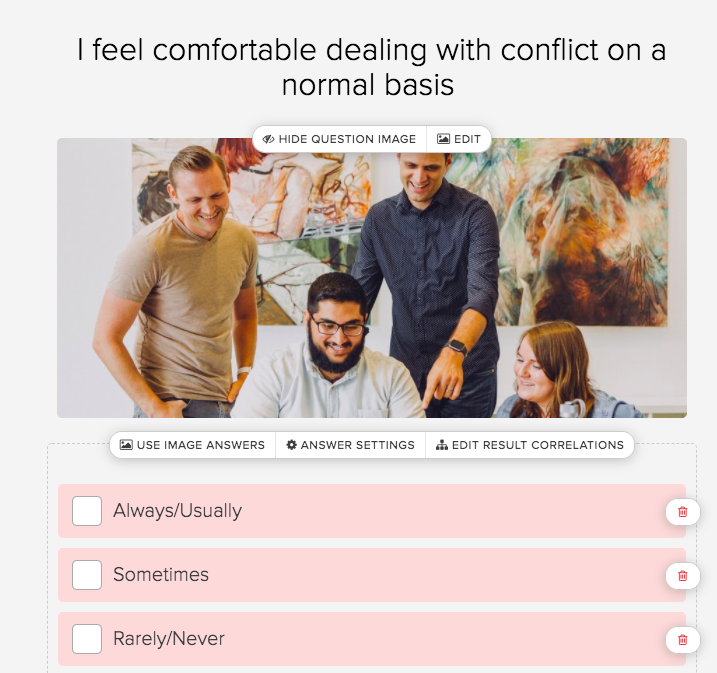
- In the workplace, I try to avoid conflict as much as possible
- Authority in a workplace makes me nervous
- I take on leadership roles with ease
- Working with others usually causes conflict, so I’d rather work alone
You can also check out 50 quiz questions you should be using and how to write quiz questions and answers from scratch for more inspiration.
2. Create content around your conflict management style quiz
There’s one thing you MUST avoid when promoting your quiz.
Don’t promote your business to quiz users without free content. The last thing someone wants is pressure to buy something right away.
After a user finds out their conflict style, offer them free resources about their type. When you encourage your audience to learn more (for free), they’ll trust and connect with your brand.
And we all know what happens when someone trusts and connects with you…they do business with you.
On that note, here are five types of free content you can offer:
Blog posts — Blog posts are easy to share with users (as mentioned in Create your results). They’re also a great lead magnet for e-books and email lists.
Here are some conflict management style blog post ideas:
- The strengths and weaknesses of each conflict management style
- Competing conflict style: How to work with a [conflict management style]
- Should you change your conflict management style?
Videos — Videos are similar to blogs but more personable. We suggest repurposing your blog posts into videos. Then you don’t have to waste time thinking about more content ideas.
Podcasts — Do you know someone with a collaborating conflict style? Interview them on your podcast! Users love to see how personality styles play out in real life.
E-books — Give your audience something to hold on to. E-books are the perfect tool to reference back to, anytime, anywhere.
Here are some e-book topics to write about:
- How to be the BEST version of [conflict management style]
- How do we form conflict management styles, anyway?
- 3 tried and tested ways to work with every conflict management style
And last, but not least: Emails. Email lists are so important that we created an entire section about them below.
3. Build an email list
An email list can SKYROCKET your organic traffic and sales. I mean, think about it: Your email list doesn’t belong to anyone but you. It’s all about your business and customers.
Once users finish your conflict management style quiz, encourage them to sign up to receive your emails. You can do this with an email opt-in page through Interact.
On your quiz editing page, click on “Set up opt-in form.”

Step 1: Most users don’t like to submit a lot of info about themselves. Luckily, you’ll only need an email address and their name.
Step 2: You might be thinking, Why would I allow users to skip the opt-in form? Doesn’t that defeat the point?
Well, not exactly. If someone feels forced to sign up for your email, they might exit out completely. It might be better to keep this optional.
Scroll down to edit your email opt-in form.
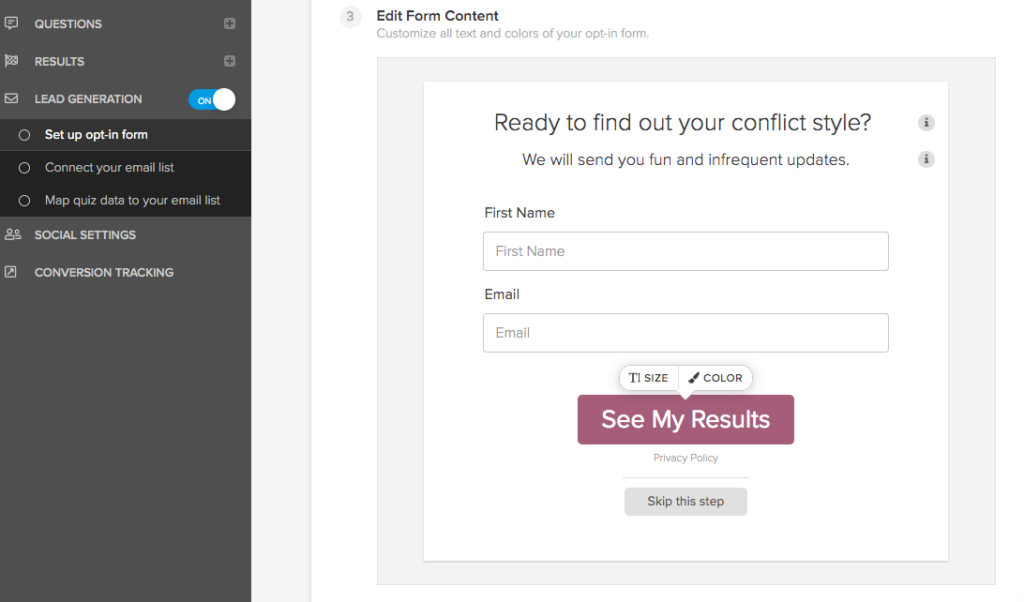
Through the next steps, you’ll connect your email marketing software to Interact and segment your email lists.
Segmentation. . . What’s that?
Segmentation is simply dividing your users into different email lists. You can personalize your content and create different email campaigns for each list.
For example, you could create segmented email lists according to quiz results. So, a user who is a competing conflict style will receive more content about competing styles.
Need help building email lists and segmentation? These guides will jumpstart your email strategy:
- Your complete guide to list building (w/ 4 email marketing templates you need)
- How to power up your market segmentation strategies for more leads and revenue
- How to build your email list using quizzes
Start creating your conflict management style quiz
We hope you enjoyed learning how to create a conflict management style quiz! Don’t forget to create a free account with us to get started.
You can check out more lead generating quiz advice from these experts, or chat with us if you have any questions. Here’s to creating your conflict management style quiz!
